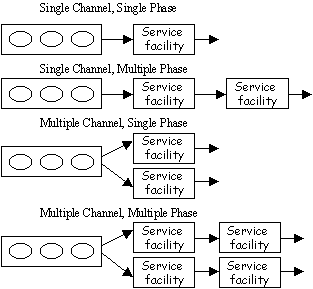Queuing System Components
1. Input Source: The input source generates customers for the service mechanism. The most important characteristic of the input source is its size. It may be either finite or infinite. Please note that the calculations are far easier for the infinite case, therefore, this assumption is often made even when the actual size is relatively large.
If the population size is finite, then the analysis of queuing model becomes more involved. The statistical pattern by which calling units are generated over time must also be specified. It may be Poisson or Exponential probability distribution.
2. Queue: It is characterized by the maximum permissible number of units that it can contain. Queues may be infinite or finite.
3. Service Discipline: It refers to the order in which members
of the queue are selected for service. Frequently, the discipline
is first come, first served.
Following are some other disciplines:
- LIFO (Last In First Out)
- SIRO (Service In Random Order)
- Priority System
4. Service Mechanism: A specification of the service mechanism
includes a description of time to complete a service and the number
of customers who are satisfied at each service event. The service
mechanism also prescribes the number and configuration of servers.
If there is more than one service facility, the calling unit may receive
service from a sequence of these. At a given facility, the unit enters
one of the parallel service channels and is completely serviced by
that server. Most elementary models assume one service facility with
either one or a finite number of servers.The following figure shows
the physical layout of service facilities.

Unusual Customer/Server Behaviour
Customer's Behaviour
Balking. A customer may not like to join the queue due to long waiting line.
Reneging. A customer may leave the queue after waiting for sometime due to impatience.
Collusion. Several customers may cooperate and only one of them may stand in the queue.
Jockeying. When there are a number of queues, a customer may move from one queue to another in hope of receiving the service quickly.
Server's Behaviour
Failure. The service may be interrupted due to failure of a server (machinery).
Changing service rates. A server may speed up or slow down, depending on the number of customers in the queue. For example, when the queue is long, a server may speed up in response to the pressure. On the contrary, it may slow down if the queue is very small.
Batch processing. A server may service several customers simultaneously, a phenomenon known as batch processing.
Assumptions of Queuing Theory
- The source population has infinite size.
- The inter-arrival time has an exponential probability distribution with a mean arrival rate of l customer arrivals per unit time.
- There is no unusual customer behaviour.
- The service discipline is FIFO.
- The service time has an exponential probability distribution with a mean service rate of m service completions per unit time.
- The mean arrival rate is less than the mean service rate, i.e., l < m.
- There is no unusual server behaviour.



